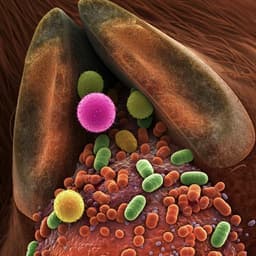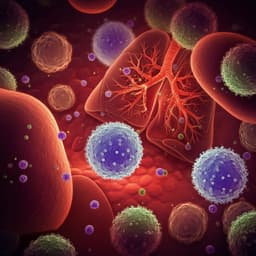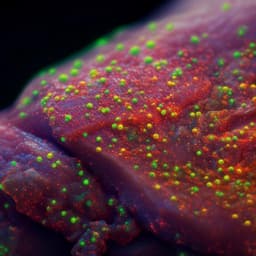
Veterinary Science
Genotypic antimicrobial resistance characterization of *E. coli* from dairy calves at high risk of respiratory disease administered enrofloxacin or tulathromycin
R. V. Pereira, C. Foditsch, et al.
This groundbreaking study investigates the lasting effects of enrofloxacin and tulathromycin on antimicrobial resistance genes in calves at high risk for bovine respiratory disease. Conducted by R. V. Pereira and colleagues, the results reveal significant findings regarding resistance selection and mutation dynamics in fecal E. coli.
~3 min • Beginner • English
Introduction
Quinolones were initially expected to be resilient to resistance development because they are synthetic and bacteria would not encounter pre-existing resistance genes in nature. Nonetheless, clinically significant resistance has emerged in Enterobacteriaceae. Fluoroquinolones are critically important in human medicine, raising concerns about the potential for use in livestock to select for resistant enteric bacteria with public health implications. Plasmid-mediated quinolone resistance (PMQR) genes (e.g., qnr families, oqxAB, qepA, and aac(6')-Ib-cr) have been identified and can co-occur with extended spectrum β-lactamase (ESBL) genes, suggesting risks of co-selection for multidrug resistance. Prior work in preweaned calves indicated that a single labeled dose of enrofloxacin can increase shedding of ciprofloxacin-resistant fecal E. coli compared with untreated calves. The objective here was to evaluate the longitudinal effect of enrofloxacin or tulathromycin administration in preweaned calves at high risk of BRD on the prevalence of antimicrobial resistance genes and QRDR mutations in fecal E. coli. The authors hypothesized that enrofloxacin treatment would increase the prevalence of genomic elements conferring fluoroquinolone resistance compared to tulathromycin-treated and untreated control calves.
Literature Review
The paper reviews evidence that PMQR exists and can be carried on mobile elements often associated with ESBLs. The first PMQR gene (qnr) was discovered on a multi-resistance plasmid in Klebsiella pneumoniae, and several qnr families (qnrA, qnrB, qnrS, qnrC, qnrD), efflux pumps (oqxAB, qepA), and the acetyltransferase variant aac(6')-Ib-cr have been described. Clinical use of quinolones exerts selection pressure that can select for quinolone resistance and co-select multidrug-resistant isolates. PMQR genes are frequently found with ESBL genes (e.g., CTX-M, TEM), potentially facilitating dissemination of resistance to β-lactams, aminoglycosides, tetracyclines, and sulfonamides. Prior studies in food animals and humans report coexistence of PMQR and ESBL determinants and associations between fluoroquinolone resistance and ESBL phenotypes. The authors also cite studies demonstrating the role of QRDR mutations (notably in gyrA, parC, parE) in stepwise selection and clonal expansion of fluoroquinolone-resistant E. coli.
Methodology
Study design and animals: This study was part of a larger project on antimicrobial resistance and microbiota in preweaned dairy calves. Protocol was approved by Cornell University's IACUC (2014-0094). Eighty-four preweaned calves (2–3 weeks old), not previously treated with antibiotics by the farm, were randomly allocated to one of three groups: ENR (enrofloxacin, 7.5 mg/kg SC, single dose), TUL (tulathromycin, 2.5 mg/kg SC, single dose), or CTL (no treatment). Calves were considered high risk for BRD per FDA NADA criteria based on exposure to wet or cold weather conditions. Sampling: Fecal samples were collected longitudinally at day 0 (treatment day) and at 2, 4, 7, 14, 21, 28, 56, and 112 days post-enrollment. Results reported for resistance genes and QRDR in the manuscript are focused on days 0, 7, 28, and 56. Culture and antimicrobial susceptibility: Fecal samples were filtered onto MacConkey agar via hydrophobic grid membrane filter, then replica-plated onto MH agar with ciprofloxacin (1 µg/mL), MH agar with ceftriaxone (1 and 4 µg/mL), MH without drugs, and CHROMagar E. coli for confirmation. From each sampling, preferentially one E. coli isolate was selected in order: resistant to both ciprofloxacin and ceftriaxone, resistant only to ciprofloxacin, resistant only to ceftriaxone, or if none met these, a susceptible isolate. Isolates were stored at −80 °C. Disk diffusion susceptibility testing followed CLSI guidelines using a modified NARMS 12-drug panel: amoxicillin/clavulanic acid, ampicillin, cefoxitin, ceftriaxone, chloramphenicol, ciprofloxacin, nalidixic acid, enrofloxacin, streptomycin, sulfisoxazole, tetracycline, and trimethoprim/sulfamethoxazole. Genotypic characterization: A total of 264 E. coli isolates phenotypically resistant to ceftriaxone (n=173) or both ceftriaxone and ciprofloxacin (n=91) were selected for genotyping. DNA was extracted using InstaGene matrix after pelleting from culture. QRDR analysis: PCR amplification of QRDR regions of gyrA, parC, gyrB, and parE used published primers; thermocycling with Q5 Hot Start master mix and gene-specific annealing temperatures (gyrA 58 °C, gyrB 59 °C, parC 55 °C, parE 60 °C). PCR products were sequenced by Sanger sequencing; variants were called using Thermo Fisher Variant Analysis. PMQR and β-lactam/tetracycline genes: Two multiplex PCR assays were used. PMQR multiplex targeted qnrA, qnrB, qnrS, qnrC, qnrD, oqxAB, qepA, and aac(6')-Ib-cr using a touchdown protocol (94 °C denaturation; 16 cycles touchdown 64.5→60 °C; then 15 cycles at 60 °C). A separate multiplex targeted bla-TEM, bla-CTX-M, bla-OXA, tetA, and tetB using a laboratory-developed touchdown protocol (94 °C; touchdown 66→58.5 °C; then 20 cycles at 54 °C). Positive controls (DNA pools from resistant E. coli and Salmonella) and negative controls (water) were included; products were visualized on 2% agarose gels. Statistical analysis: Descriptive statistics and Pearson chi-square screening (P≤0.10) were performed in JMP 15. Sensitivity and specificity of genotype or QRDR mutation profiles for predicting phenotypic resistance were calculated using standard definitions (TP, TN, FP, FN). Associations between resistance genes or QRDR mutations and treatment group by time point were evaluated with mixed logistic regression (PROC GLIMMIX, SAS), including treatment, time, and their interaction as fixed effects, with animal ID as a random effect to account for repeated measures. Where genes/mutations were absent in some cells, Fisher’s exact tests by time point (PROC FREQ) were used. Significance was set at P≤0.05.
Key Findings
- Enrollment and isolates: 84 calves enrolled; 67 completed follow-up (loss to follow-up or treatment for diarrhea excluded: ENR 6/22, CTL 7/21, TUL 5/24). In total, 264 E. coli isolates were genotyped (173 ceftriaxone-resistant only; 91 resistant to both ceftriaxone and ciprofloxacin).
- Resistance genes detected: Only aac(6')Ib-cr (n=13), bla-CTX-M (n=51), bla-TEM (n=117), tetA (n=142), and tetB (n=101) were found; bla-OXA was not detected.
- PMQR: The only PMQR detected was aac(6')Ib-cr. Distribution: CTL 1/21 at day 28; ENR 5/22 at day 7 and 4/22 at day 28; TUL 1/24 at day 7 and 2/24 at day 28. Fisher’s exact test showed ENR had significantly more aac(6')Ib-cr at day 7 vs CTL (5/22 vs 0/21; P=0.048). By day 56, aac(6')Ib-cr was absent in all groups.
- Tetracycline genes: ENR had significantly more tetA at day 28 than CTL (13/22 vs 5/21; P=0.03). Both tetA and tetB generally decreased in prevalence by day 56.
- QRDR mutations: Only 17 of 108 QRDR mutations were in isolates with phenotypic quinolone resistance. The most common mutation overall was gyrA 594 (T→C). Five QRDR mutations were associated with ciprofloxacin resistance: parC 239 (G→T), gyrA 248 (C→T), gyrA 259 (G→A), gyrA 570 (C→T), parE 1372 (T→G).
- Treatment effect on QRDR: Mixed logistic regression showed significantly higher odds of detecting gyrA 248 (C→T) in ENR vs CTL at day 7 (OR 11.59; 95% CI 1.22–109.65; P=0.03) and a trend at day 28 (OR 9.01; 95% CI 0.95–85; P≈0.055). At day 0, ENR had lower odds vs CTL (OR 0.10; 95% CI 0.02–0.54; P=0.008). No other QRDR mutations remained significant in mixed models (parC 239 and parC 273 showed trends).
- QRDR profiles and predictive performance: The QRDR profile combining parC 239 (G→T), gyrA 248 (C→T), gyrA 259 (G→A), gyrA 570 (C→T), and parE 1372 (T→G) had high diagnostic performance for ciprofloxacin resistance (Se ≈74.3%, Sp ≈99.5%).
- Co-occurrence and MDR: All 13 aac(6')Ib-cr–positive isolates also had parC 239, gyrA 248, and gyrA 259 mutations and carried CTX-M and tetA, displaying an MDR phenotype to 11 antimicrobials. The most common genotypic profile was bla-TEM tetA tetB (n=73/264), frequently corresponding to MDR phenotypes; the second notable MDR genotype was aac(6')Ib-cr CTX-M tetA (n=13/264), with 92% showing MDR phenotypes including resistance to ciprofloxacin and ceftriaxone.
Discussion
Enrofloxacin administration to high-risk preweaned calves was associated with selection for fluoroquinolone resistance determinants shortly after treatment. ENR significantly increased the odds of detecting the QRDR mutation gyrA 248 at 7 days and showed a near-significant increase at 28 days versus controls, consistent with early gyrA mutations as initial steps toward higher-level quinolone resistance. ENR also transiently selected for the PMQR gene aac(6')Ib-cr at day 7, supporting the role of ENR in promoting low-level resistance mechanisms that can facilitate subsequent acquisition of chromosomal mutations leading to higher-level resistance. The decline and disappearance of aac(6')Ib-cr by day 56 in all groups suggests a limited temporal advantage and potential fitness costs in a maturing gut microbiota, particularly across the weaning transition. The frequent co-occurrence of PMQR with ESBL genes (e.g., CTX-M) and tetracycline resistance (tetA) and the strong MDR phenotypes observed underscore concerns for co-selection of multidrug resistance during antimicrobial exposures. The clustering of specific QRDR mutations and resistance gene profiles indicates possible clonal expansion of adapted strains under selective pressure, followed by decline as ecological competition intensifies. These findings address the hypothesis by demonstrating that enrofloxacin, but not tulathromycin, increased specific fluoroquinolone resistance determinants in fecal E. coli over time, with implications for antimicrobial stewardship in calf health management.
Conclusion
Treatment of preweaned calves at high risk of BRD with enrofloxacin resulted in significantly higher detection of the QRDR mutation gyrA 248 at 7 and 28 days and a higher prevalence of the PMQR gene aac(6')Ib-cr at day 7 compared with controls. The study highlights the potential for enrofloxacin use to select and transiently maintain fluoroquinolone resistance determinants and MDR genotypes in fecal E. coli. Continued research is warranted to elucidate factors driving the selection and persistence of MDR isolates, particularly those co-resistant to fluoroquinolones and cephalosporins, and to develop targeted interventions and prudent-use strategies in veterinary settings.
Limitations
- Susceptibility interpretations primarily used human-origin CLSI breakpoints due to limited veterinary-specific criteria, which may affect phenotype classification for cattle isolates.
- Selective culture and isolate selection prioritized resistant phenotypes (ceftriaxone and/or ciprofloxacin), potentially enriching for resistance and limiting generalizability to all fecal E. coli.
- Use of selective media can risk misidentification, although CHROMagar E. coli has high reported accuracy.
- Microbiota shifts associated with calf maturation and the weaning transition (day 56 samples were post-weaning) may confound temporal patterns of resistance gene prevalence.
- Attrition of enrolled calves reduced sample size and may influence power at later time points.
Related Publications
Explore these studies to deepen your understanding of the subject.







